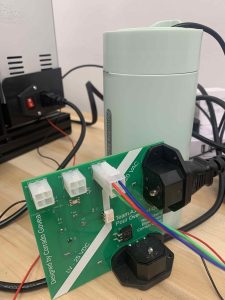Attached is the poster created by the team for our demo day!
https://docs.google.com/presentation/d/1vygu6m0Y-9RZ-Gl3t9SFnsPY7yQNA1Dq/edit?usp=sharing&ouid=116482161551242473837&rtpof=true&sd=true
Attached is the poster created by the team for our demo day!
https://docs.google.com/presentation/d/1vygu6m0Y-9RZ-Gl3t9SFnsPY7yQNA1Dq/edit?usp=sharing&ouid=116482161551242473837&rtpof=true&sd=true
This week’s accomplishments
Next Week’s Deliverables
Status Report: On Schedule
This week’s accomplishments
Next weeks plan
Status Report: On schedule
This week’s accomplishments
Next weeks plan
Status Report: On schedule


What are the most significant risks that could jeopardize the success of the project? How are these risks being managed? What contingency plans are ready?
The main risk we have right now is our control loop for the pump to stop working. We have been running into a hardware bug that we haven’t been able to figure out where after a certain amount of time of testing the pump, it no longer receives any signals or voltage from its power supply. We imagine this should not be an issue during the final demo due to it only happening after 5+ hours of testing. Unfortunately, we do not have a contingency plan as swapping out a pump is not as simple as it sounds thus we will make sure not to stress it too much before demo day. In the event of total pump failure, we are still able to demonstrate pour patters as well as the entire webapp, we just will not be able to brew coffee.
List all unit tests and overall system test carried out for experimentation of the system. List any findings and design changes made from your analysis of test results and other data obtained from the experimentation.
Flow rate test – Through this we learned that there was a minimum and maximum current that we could send the pump before it didn’t spin at all, thus we had to add a physical flower restrictor to change its flowrate as well
Water heater test – Through this we learned that our initial PID implementation had a small overshoot in terms of the temperature it would achieve. We repeated this test until we were able to refine our PID values to get a temperature +/- 5 degrees of the desired temperature
UI/UX stress test – Through collecting data for UX of our webapp we learned of some pain points for user unfamiliar with pour over coffee. We have since implemented features to help alleviate these, such as active step highlighting, profile sorting, and a friendly little coffee bean guy!
This week’s accomplishments

Next Week’s Deliverables
Status Report: On Schedule
This week’s accomplishments
Next weeks plan
Status Report: On schedule
This week the team continued to work on the full system integration leading up to the internal “MVP”. Currently, the software is finished until we can get the water pump circuit working and integrated with the Arduino. We ran into an issue this week where we noticed that the scale seemed to drift in the weight that it was reading, thus we are looking into this more. Currently, the code does not rely on the scale weight so it shouldn’t impact our ability to reach MVP. We have speculated that this could be due to the Arduino not supplying enough power, but further testing is necessary to see if that is the case.
On the hardware side, the team (finally) got the pump to work with the circuit. The flow rate can be controlled through a PWM signal from the Arduino. The team will be testing the exact flow rates the pump can produce in the near future.
In terms of design requirements, we are currently meeting the following:
The rest of the design requirements are currently untestable until we get the water pump fully integrated, which will be happening sometime this week.
This week’s accomplishments
Next weeks plan
Status Report: On schedule

New tools/knowledge
This week, the team worked on full system integration leading up to our internal “MVP” — that is, all systems work to some extent, but all working together. The Kettle + PID loop and the 3D gantry can be controlled wirelessly, and we got a new pump, characterized it, and verified that it has enough power to prime itself.
At this point, all major systems are in an operating state, so next week we will work on assembling everything together so that we can start tuning the controls — this is important, as factors like height difference between the water reservoir and the nozzle can have an impact on flowrate.
The highest risk at the moment is ensuring that our current design meets the design requirements — for that reason, as we tune, we will start checking off on most of these requirements so that we can identify early if anything needs to be modified.
Extra: note on System Validation
We need to ensure that our product, as defined by our design requirements, meets the use case requirements that we defined early on in the semester. To do this, we plan on creating a simplified survey with a clear, measurable metric for each of our use case requirements, and we will try to collect as much field data as possible to determine if there are any areas that need to be improved from the consumer’s side.